Living Stone Plant (Lithops): Care and Growing Guide (Pictures)
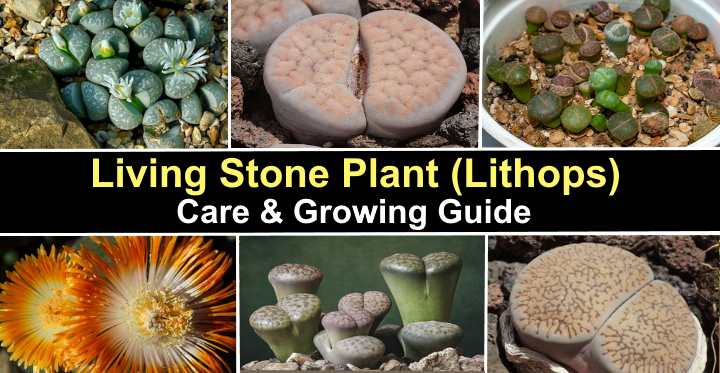
Lithops is a succulent that is also called living stone plant and is easy to grow indoors. The plant’s common name—living stone—comes from the fact that the succulent looks like a small rock, pebble, or stone. The unusual feature of lithops plants is their two fleshy succulent leaves in a kidney bean shape. The fissure between the two plump lithops leaves splits, and then a flower or a pair of new leaves emerge.
Lithops are common plants for succulent gardens. Their stone-like appearance creates interesting features growing alongside other succulents. In time, lithops can grow into small clumps of plump, fleshy plants.
This article is a complete care guide to growing living stone plants at home. Although the rock-like succulents are easy to grow, it’s vital to know their life cycle and how to water lithops correctly and create the optimal growing environment.
How to Care for Lithops (Living Stone Plants)
To care for lithops indoors, grow the living stone plant in full sun and dry sandy soil. Watering is the most critical aspect of lithops care. Only water a living stone plant in the fall and spring. The optimal temperature range for growth is 65°F to 80°F (18°C – 26°C).
What is the Living Stone Plant (Lithops Succulent)
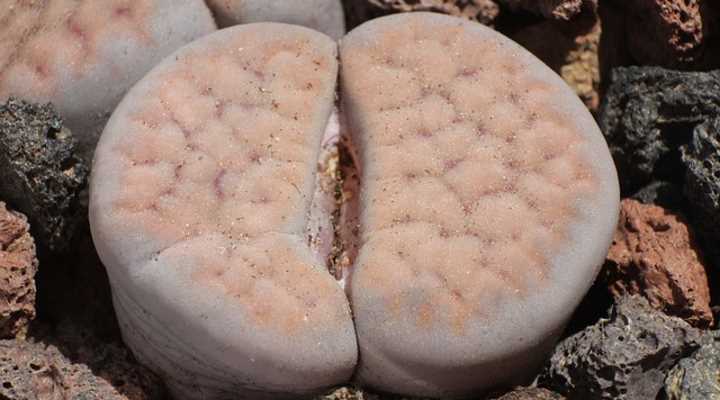
Living stone (Lithops) is a flowering succulent that can survive a long time without water
Lithops is a type of flowering succulent native to the hot, dry climate of southern Africa. Lithops is the scientific and common name of this unusual succulent, and it belongs to the ice plant family Aizoaceae. The name lithops is both the singular and plural name.
Because it resembles rocks, lithops succulents also go by the names pebble plants, living stones, and split rocks. The botanical name means “stone-faced” or “similar to a stone.”
Most species of lithops grow up to 1” (2.5 cm) tall and between 1” and 3” (2.5 – 7.5 cm) wide. Lithops leaves store moisture, and this feature allows the succulent to last for months without water. Some lithops species grow in climates where it never rains for years. Others survive on one or two periods of rain per year.
Almost all the plant is underground. In the wild, only a few millimeters of the leaf tops are visible above the ground. This growth feature makes finding lithops growing in deserts particularly challenging. The succulents resemble tiny rocks or pebbles and are difficult to identify among stones on the ground.
There are nearly 40 lithops species and over 145 different varieties. All species of lithops have a fissure between the fused leaves that splits when flowering or when new leaves emerge.
The stone-like succulents can be green, brown, creamy-white, bluish-green, orangey-red, or dusty pink. The flat tops of the succulent leaves usually have intricate patterns of lines, dots, or colorful markings.
Some types of colorful living stone plants include Lithops aucampiae, Lithops dorotheae, ‘Karas Mountains Living Stone’ (Lithops karasmontana), ‘Lesliei Living Stone’ (Lithops lesliei), and ‘Green-Rock Plant’ (Lithops viridis).
Living Stone (Lithops) Flower
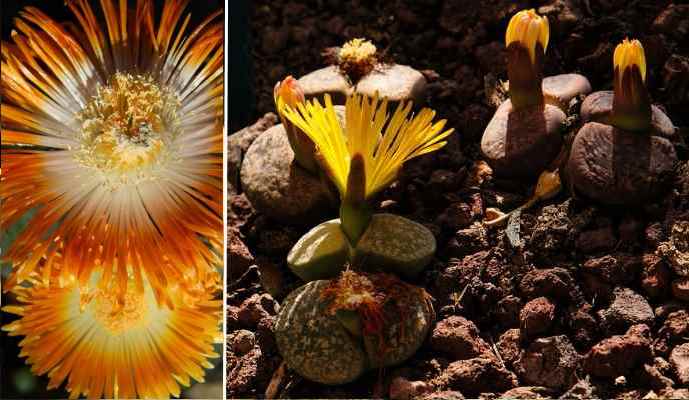
Lithops flowers come in different colors depending on the species
Lithops are flowering succulents that produce daisy-like flowers in late fall and early winter. The star-shaped flowers have rays of slender petals around a yellow center. Lithops flowers can be white, yellow, lilac, orange, and vibrant pink. Living stone flowers emerge from the fissure and bloom during the afternoon on sunny days.
How to Grow Lithops from Seeds
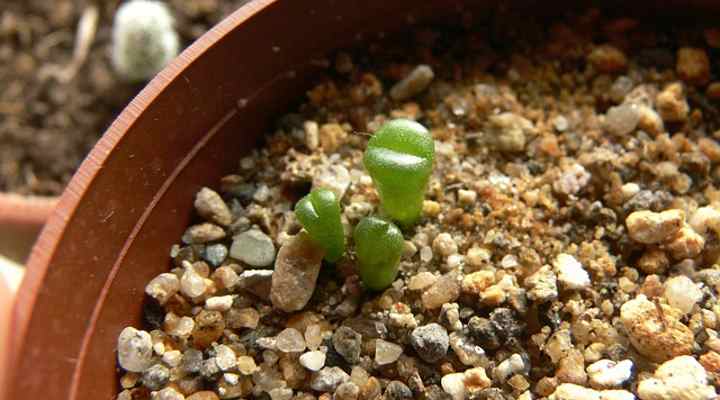
Lithops seedlings
Living stone plants are easy to grow from seed. All you need to do is sprinkle lithops seeds on a well-draining, moist potting mix. Lightly cover the seeds with a layer of sand. Spray a fine mist on the soil and cover it with plastic to lock in heat and moisture. Place on a sunny windowsill and keep the soil slightly moist.
After 12 weeks, the lithops seeds should germinate. Then, you can remove the plastic cover and transfer the seedlings to individual pots to continue growing. Only water the living stone plants when the soil completely dries.
Another method of lithops propagation is by plant division.
Lithops Growth Cycle
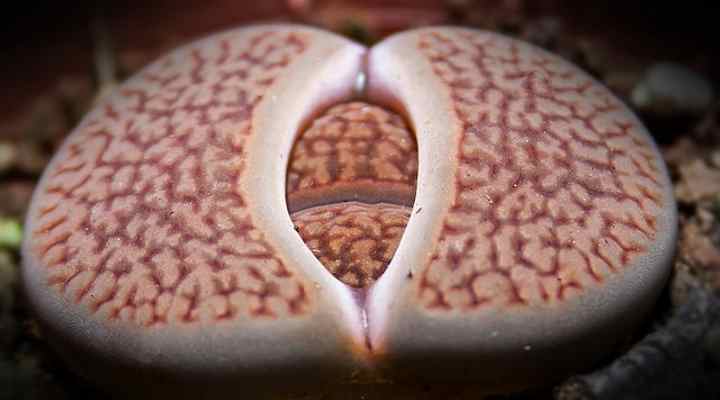
After flowering has finished, lithops grow new pair of leaves and the old leaves will die
Understanding the growth cycle of living stone plants is key to growing them successfully. For example, a common mistake in growing lithops is to overwater or water them in the wrong season. However, knowing how lithops grow will help you care for them properly.
After the plant is three years old, lithops plants flower in the fall. Once the flowers fade, a seed capsule forms in the center. Any moisture in the center will stimulate the capsule to open and release seeds. After blooming, new succulent leaves grow under the plant. The old leaves will begin to wilt during winter as the new leaves draw moisture from the old ones. Then in spring, the new, plump leaves should be visible. A lithops plant is dormant in summer.
The only time lithops needs water during its yearly lifecycle is in early fall, when the plant resumes growing and begins to flower. Then again in spring, after the old leaves have withered and died and the two new ones start to appear. Proper watering will mean that your lithops plants should grow for 40 to 50 years.
Living Stone Plant (Lithops) Care Guide
Let’s look in detail at the best way to grow a collection of living stone plants in your home or your tropical garden.
How to Water Lithops
Only water lithops two times a year to keep it healthy. The time to water lithops is in the fall when growth resumes, and the succulent begins to flower. The other time is in spring when the new leaves appear. At other times, don’t water lithops.
Proper watering techniques are vital to keeping a lithops plant healthy. To water the succulent, drench the soil until it drains from the pot’s drainage holes. The next time to water your lithops plants is when the soil dries out completely—usually around every two weeks.
Watering lithops depends on its yearly growth cycle and seasonal habits. For example, lithops are dormant in summer and require no watering. Then, watering the soil in fall and spring helps the succulent bloom and new leaves appear. Also, you must hold off watering lithops during winter.
The only reason to water a lithops plant in summer is if the leaves appear wrinkled and are drying out. In that case, water early in the morning and only give a small amount of water.
Why shouldn’t you water lithops in winter? This answer is to do with its growth habits. New leaves take moisture from the old leaves during winter. If you water the plant at this time, the old leaves will continue to try and grow, resulting in both sets of leaves dying.
It’s good to remember that you may never need to water the succulents if the lithops get enough moisture from a humid environment.
Tips on watering lithops correctly
Here are a few handy tips when it comes to watering living stone plants:
- Overwatering a lithops can result in root rot.
- Only water the plants occasionally and in line with their seasonal growth habits.
- Allow lithops to dry out during summer and winter.
- Begin watering in the fall when the fissure begins to separate.
- Resume watering in spring when the old leaves are completely withered.
- Watering lithops is similar to watering cactus plants.
Lithops Light Requirements
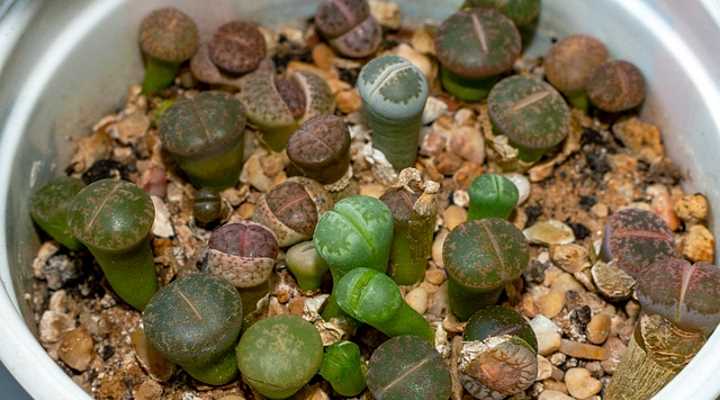
Lithops need 4-5 hours of direct sunlight daily
Lithops thrive when they get four to five hours of direct sunlight daily. The best place to grow lithops indoors is at a south-facing window or on an east-facing windowsill. Too little sunlight can affect the lithops growth and cause the leaves to be yellow or become stretched.
One of the reasons why lithops die is inadequate sunlight.
It’s good to remember that lithops may need adjusting to bright sunlight after the dark winter months. So before putting a lithops in full sunshine in early spring, try to increase full sun exposure gradually. This way, you’ll prevent stress and avoid sunburning the fleshy leaves.
The Best Soil for Growing Lithops
The best growing medium for living stone plants is a soil mix for cactus plants. To make a lithops soil mix, combine one part of regular houseplant soil with two parts of perlite, coarse sand, or crushed gravel. Amending the soil with rough, inorganic material improves drainage for healthy growth.
Too much moisture retention can be detrimental to lithops growth. Damp soil causes root rot and allows pests to thrive. In their natural habitat, lithops plants grow in sandy deserts and rocky ground.
When choosing a pot for lithops, pick one that seems larger than necessary. This is because lithops have extensive root systems and need room to grow. Also, make sure the pot has drainage holes to prevent soggy soil.
Related reading: How to care for succulents.
Living Stone Plant Temperature Requirements
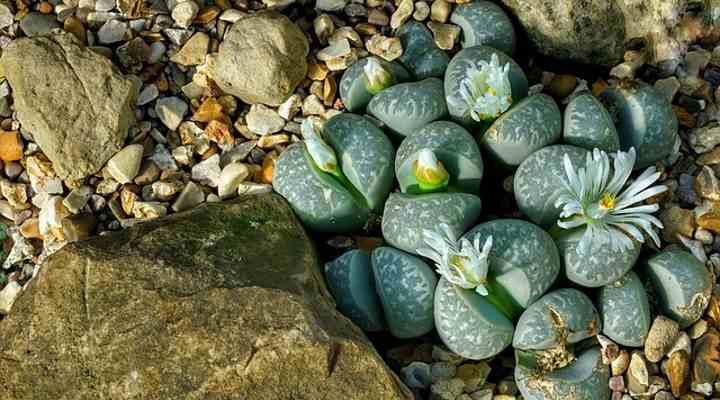
Lithops grow best in temperature range of 65°F to 80°F (18°C – 26°C)
Lithops thrive in average household temperatures if they get enough sunlight. The best temperature range for lithops is 65°F to 80°F (18°C – 26°C). The minimum temperature for lithops is 55°F (12°C), but any temperature below freezing will kill the heat-loving succulents.
You can grow lithops outside in a succulent garden if you live in USDA zone 10 or 11. If outdoor temperatures don’t dip below 55°F (12°C), you can grow living stone plants and rock succulents throughout winter. However, in zones 9 and below, lithops grow best indoors.
How to Fertilize Lithops (Living Stone Plant)
Lithops grow well in poor soil and don’t need additional fertilization. In their native habitat, lithops grow in sandy soil without any organic matter. However, you can add a heavily diluted cactus fertilizer in late summer if you want to encourage blooming. Ideally, a high-potassium, low-nitrogen fertilizer is necessary.
How to Propagate Living Stone Succulents
You can propagate lithops by division or seed – although both methods take a long time. Propagating lithops by root division is done if you have a cluster of plants which takes several years to develop. To propagate the living stones, remove the clump from the pot and dust down the roots. Then, look for suitable places to cut the roots, ensuring at least one plant is attached.
To ensure successful propagation, lithops need a good amount of taproot attached to each pair of leaves.
Repotting Living Stone Plants
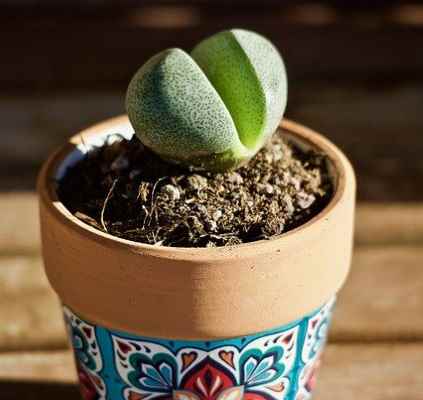
You only need to repot lithops succulents when you propagate them
The only time lithops require repotting is when you propagate them. To repot a lithops, create a fresh, well-draining cactus mix. Then, plant the living stone with its leaf tops about 0.5” (1.2 cm) above the soil’s surface. Also, try not to disturb the taproot too much when repotting, as it’s vital for the plant’s growth.
Living stone plants can live up to 20 years in the same pot. When repotting, choose a terracotta pot that is at least 5” (13 cm) deep. This gives the plant’s roots enough room.
To create an attractive succulent garden in a pot, you can decorate the soil with real pebbles, gravel, or stones to create a natural environment for your living stone succulents.
Pests Affecting Lithops Care
Most houseplant pests stay away from living stones. However, the most common bugs to affect the plant’s growth are spider mites. Spider mites tend to thrive in the type of dry environments that lithops require. Signs of spider mites include pale white spots or tiny web-like strands on the plant or between the leaves.
If you notice that there are white scar spots on the fleshy leaves or signs of webbing, use neem oil to eradicate them. Mix 2 tsp. neem oil, 1 tsp. Castile soap, and 1 quart (1 l) of water in a spray bottle. Spray lithops once a week to get rid of spider mites.
On rare occasions, mealybugs, aphids, or thrips can affect succulents such as lithops.
Related reading: How to use neem oil for houseplant pest control.
Diseases Affecting Lithops Growth
The only plant diseases affecting lithops are root rot caused by overwatering. Excess moisture in the soil causes the roots to decay and the leaves to crack. If you water lithops in line with its seasonal habits and only when the soil is dry, you shouldn’t have any succulent plant disease issues.
Is Lithops Toxic?
Lithops are not poisonous to dogs or cats. The ASPCA has living stone plants on its list of non-toxic plants to animals.
Additionally, the University of California lists lithops on its list of plants that are safe for humans.
FAQs About Lithops and Their Care

What are blue lithops?
Some online retailers sell blue lithops called “Blue Witchford Lithops.” The living stones appear in vibrant hues of blue from light, sky blue to deep blue. Unfortunately, most images of blue lithops for sale online are fake and have been photoshopped to make them appear blue.
What to do about overwatered lithops?
To save an overwatered lithops from dying, it’s vital to dry the roots as soon as possible. Remove the small living stone plants from the soggy soil and remove any mushy roots. Allow the roots to dry for a few days. If there is no damage to the leaves, replant the lithops in well-draining sandy soil.
A sign of an overwatered lithops is vertical lines on the sides of the fleshy, wrinkly leaves.
To prevent further damage, only water the plant two times a year—only in early fall and early spring.
How long does it take for lithops to split?
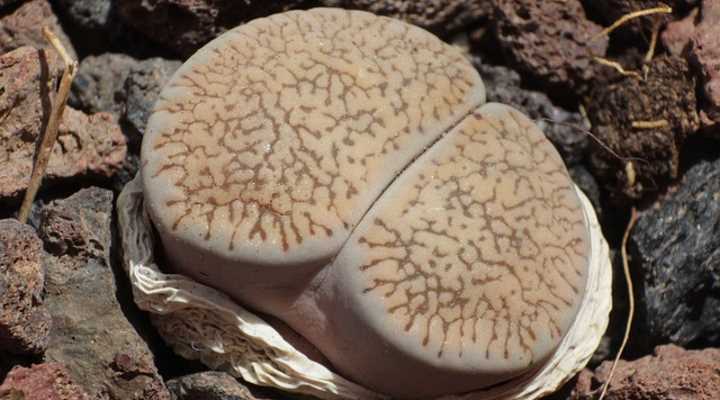
Lithops take one or two months to split and for the flower to emerge. During this time, it’s essential to leave the plant alone and refrain from watering it during the splitting process.
Why are my lithops wrinkly?
Like most succulents, lithops become wrinkled if they don’t get enough water. The living stone plants can survive for weeks or months without water. But some species require more watering than others. You will know if you need to water a lithops by the wavy lines across the leaves.
Remember, the leaves of a lithops plant naturally shrivel and wrinkle when they die and before new leaves emerge. If it’s the start of the growing season, you don’t need to worry about wrinkled lithops leaves.
How can I tell if my lithops are dying?
Signs that a lithops plant is stressed and is dying include yellowing leaves, wilting, signs of shriveling, and mushy leaves near the soil line. Usually, the main reason a lithops dies is overwatering. However, insufficient sunlight can also kill a lithops plant. So, ensure that the lithops isn’t suffering from too much moisture or too little sunshine.
Related articles:
